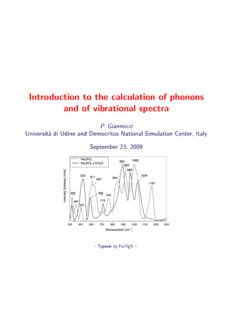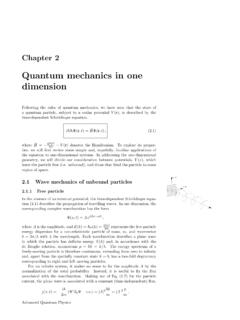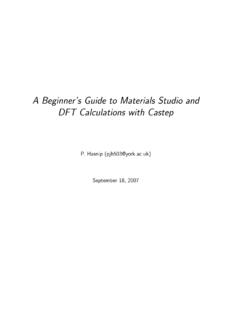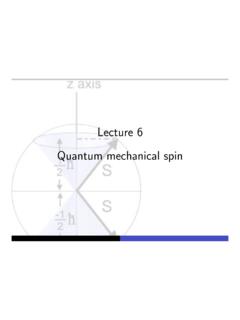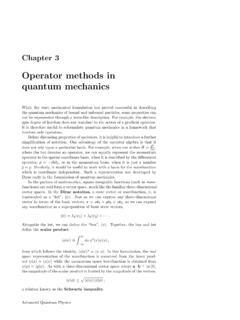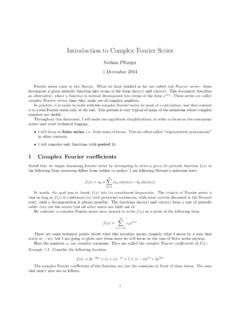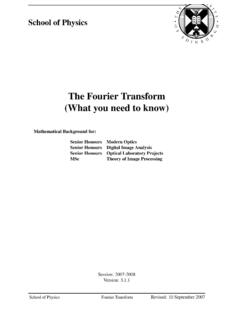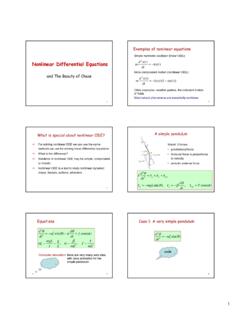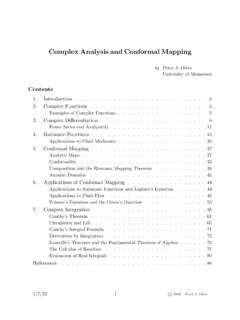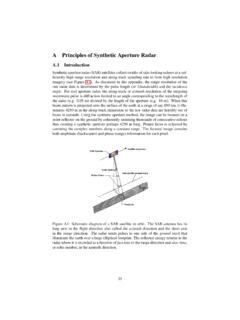Transcription of Chapter 2 Second Quantisation - University of Cambridge
1 Chapter 2 Second QuantisationIn this section we introduce the method of Second Quantisation , the basic framework forthe formulation of many-body quantum systems. The first part of the section focuses onmethodology and notation, while the remainder is devoted to physically-motivated appli-cations. Examples of the operator formalism are taken from various fields of quantumcondensed Notations and DefinitionsSecond Quantisation provides a basic and e cient language in which to formulate many-particle systems. As such, extensive introductions to the concept can be found throughoutthe literature (see, , Feynman s text on Statistical Mechanics [10]). The first partof this section will be concerned with the introduction of the basic elements of secondquantisation, while the remainder of this section will be concerned with developing fluencyin the method by addressing a number of physical us begin by defining the (normalised) wavefunctions| iand corresponding eigen-values of the single-particle Hamiltonian H,viz.
2 H| i= | this definition, populating states 1 and 2, the symmetrised (normalised) two-particlewavefunction for fermions and bosons is respectively given by FB(x1,x2)=1p2( 1(x1) 2(x2) 2(x1) 1(x2)).In the Dirac bracket representation, we can write|1,2iFB 1p2(| 1i | 2i | 2i | 1i).More generally, asymmetrisedN-particle wavefunction of fermions ( = 1) or bosons( =+1)isexpressedintheform| 1, 2,.. Ni 1pN!Q1 =0n !XP P| P1i | | PNiQuantum Condensed Matter Field Theory20 Chapter 2. Second Quantisation wheren is the total number of particles in state (for fermions, Pauli exclusion en-forces the constraintn =0,1, ! = 1) see Fig. The summation runs overallN!permutationsofthesetofquantumnu mbers{ 1,.. N},andPdenotes theEnrico Fermi1901-1954: 1938 Nobel Laureate in Physics for hisdemonstrations of the existence ofnew radioactive elements producedby neutron irradiation, and for hisrelated discovery of nuclear reactionsbrought about by slow , defined as the number of trans-positions of two elements which bringsthe permutation (P1,P2, PN)backto the ordered sequence (1,2, N).
3 Note that the summation over per-mutations is necessitated by quantummechanicalindistinguishability:fo rbosons/fermions the wavefunction hasto be symmetric/anti-symmetric under particle exchange. It is straightforward to confirmthat the prefactor1pN!Q n !normalises the many-body wavefunction. In the fermioniccase, the many-body wavefunction is known as aSlater determinant. n 4 33 2 1111111 00n 05bosonsfermionsFigure :Schematic showing typical occupation numbers for a generic fermionic and expression above makes it clear that this first quantised representation of themany-body wavefunction is clumsy. We will see that the Second Quantisation provides themeans to heavily condense the representation. Let us define thevacuum state| i,andintroduce a set offield operatorsa together with their adjointsa ,asfollows:1a | i=0,1pQ n !a N a 1| i=| 1, 2,.. Ni( )Physically, the operatora creates a particle in state while the operatea annhilates definitions are far from innocent and deserve some qualification.
4 Firstly, in ordernot to be at conflict with the symmetry of the wavefunction, the operatorsa have tofulfill the commutation relations,ha ,a i = , ,ha ,a i =0,ha ,a i =0( )1As before, it will be convenient to represent these operators without a Condensed Matter Field NOTATIONS AND DEFINITIONS21where [ A, B] A B B Ais the commutator =1(anticommutator = 1) for bosons(fermions).2 The most straightforward way to understand this condition is to check thatthe definition| , i=a a | iand property| , i= | , iin fact necessitate Eqs. ( ).Yet even if ( ) is understood, the definitions above remain non-trivial. Actually, quite astrong statement has been made: foranyN,theN-body wavefunction can be generatedby an application of a set ofN-independentoperators to a unique vacuum state. In order tocheck that Eqs. ( ) and ( ) actually represent a valid definition, including, for instance,the right symmetrisation and normalisation properties ofN-body wave functions, variousconsistency checks have to be on Eqs.
5 ( ) and ( ), a formal definition of the general many-body orFockspacecan now be given as follows. First defineFNto be the linear span of allN-particle states| 1, Ni=1pQ n a N a 1| then defined asthe direct sum 1N=0FN(see Fig. ).3 Ageneralstate| iof the Fock space is, therefore,+a+ :Visualisation of the generation of the Fock-subspacesFNby repeated action ofcreation operators onto the vacuum into a valuable tool for practical computation we need to put them into relationwith standard operations performed in quantum mechanics. In particular we have tospecify how changes from one single-particle basis{ }to another{ }e ect the operatoralgebra{a },andinwhatwaystandardoperatorsof(many-b ody)quantummechanicscan be represented in terms of thea s:.Change of basis:Using the resolution of identity, id =P1 =0| ih |,therelations| i=P | ih | i,| i a | i,and| i a | iimmediately give rise to the transformationlawa =P h | ia ,a =P h | ia ( )In many applications we are not dealing with a set of discrete quantum numbers (spin,quantised momenta, etc.)
6 , but rather with a continuum (a continuous position coordinate,say). In these cases, the quantum numbers are commonly denoted in a bracket notationa ;a(x)=P hx| ia ,andthesummationsappearinginthetransform ationformulaabove become a convention, when unspecified by , the notation [ , ] will be used to denote the commutator and{ , }the , the symbol of the direct sum is used to show that each submodule FNis linearly Condensed Matter Field Theory22 Chapter 2. Second QUANTISATIONE xample:The transformation from the coordinate to the momentum representationin a finite one-dimensional system of lengthLwould readak=ZL0dxhk|xia(x),a(x)=Xkhx|kiak,whe rehk|xi hx|ki =1L1/2e ikx, cf. fourier series of operators (one-body):Single particle or one-body operators O1acting in aN-particleHilbert space,FN,generallytaketheform O1=PNn=1 on,where onis an ordinary single-particle operator acting on then-th particle. A typicalDavid Hilbert1862-1943: His work ingeometry had the greatest influence inthat area after Euclid.
7 A systematic studyof the axioms of Euclidean geometry ledHilbert to propose 21 such axioms andhe analysed their significance. He con-tributed to many areas of is the kinetic energy op-erator T=Pn p2n2m,where pnisthe momentum operator acting onthen-th particle. Other examplesinclude the one-particle potentialoperator V=PnV( xn), whereV(x)isascalarpotential,thetotal spin-operatorPn Sn, we have seen that, by applying field operators to the vacuum space, we can gener-ate the Fock space in general and anyN-particle Hilbert space in particular, it must bepossible to represent any operator O1in , although the representation ofn-body operators is after all quite straightforward,the construction can, at first sight, seem daunting. A convenient way of finding such arepresentation is to express the operator in terms of a basis in which it is diagonal, andonly later transform to an arbitrary basis. For this purpose it is useful to define theoccupation number operator n =a a ( )with the property that, for bosons or fermions (exercise), n (a )n| i=n(a )n| i, state (a )n| iis an eigenstate of the number operator with eigenvaluen.
8 When actingupon a state| 1, 2, Ni,itisastraightforwardexercisetoconfirm thatthenumberoperator simply counts the number of particles in state , n | 1, 2, Ni=a a 1pQ n !a N a 1| i=NXi=1 i| 1, 2, us now consider a one-body operator, O1,whichisdiagonalintheorthonormalbasis| i, o=P o | ih |,o =h | o| i. With this definition, one findsh 01, 0N| O1| 1, Ni= NXi=1o i!h 01, 0N| 1, Ni=h 01, 0N|1X =0o n | 1, Condensed Matter Field NOTATIONS AND DEFINITIONS23 Since this equality holds for any set of states, we obtain the operator or Second quantisedrepresentation O1=P1 =0o n =P1 =0h | o| ia a .Theresultisstraightforward;aWolfgang Pauli1900-1958:1945 Nobel Laureate in Physicsfor the discovery of the Exclu-sion Principle, also called thePauli operator engages a single particleat a time the others are just the diagonal representation, one simplycounts the number of particles in a state and multiplies by the corresponding eigen-value of the one-body operator.
9 Finally, bytransforming from the diagonal representa-tion to a general basis, one obtains the result, O1=X h | io h | ia a =X h | o| ia a ( )Formally, the one-body operator, O1,scattersaparticlefromastate into a state withprobability amplitudeh | o| :Thetotal spin operatoris given by S=X 0a S 0a 0,S 0=12 0( )where =",#is the spin quantum number, denotes the set of additional quantumnumbers ( coordinate), and denotes the vector of Pauli spin matrices x= 0110 , y= 0 ii0 , z= 100 1 ,( ) Sz=12P ( n " n #), and S+=P a "a #. Second quantised in the position representation, theone-body Hamiltonianis givenas a sum of kinetic and potential energy as (exercise) H= T+ V=Zdx a (x) p22m+V(x) a(x)where p= (Note that the latter is easily proved by expressing the kinetic energyin the diagonal ( momentum) representation see problem set.)Finally, thetotal occupation number operatoris defined as N=Rdx a (x)a(x)..Representation of operators (two-body):Two-body operators O2are needed todescribepairwise interactionsbetween particles.
10 Although pair-interaction potentials arestraightforwardly included intoclassicalmany-body theories, their embedding into con-ventional many-body quantum mechanics is made awkward by particle indistinguishabil-ity. As compared to the conventional description, the formulation of interaction processeswithin the language of Second Quantisation is considerably more , let us consider particles subject to the symmetric two-body potentialV(x, x0) V(x0,x). Acting on two-particle states, the operator is given by V(2)=12 ZdxZdx0|x, x0iV(x, x0)hx, x0|.( )Quantum Condensed Matter Field Theory24 Chapter 2. Second QUANTISATIONOur aim is to find an operator Vin Second quantised form whose action on a many-bodystate gives V|x1,x2, xNi=NXn<mV(xn,xm)|x1,x2, xNi=12 NXn6=mV(xn,xm)|x1,x2, this expressions with ( ) one might immediately guess that V=12 ZdxZdx0a (x)a (x0)V(x, x0)a(x0)a(x).That this is the correct answer can be confirmed by applying the operator to a many-bodystate.
